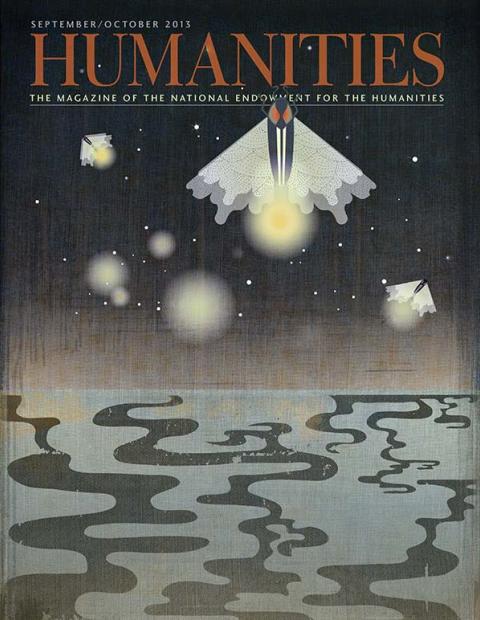Lucy Flucker of Boston and Peggy Shippen of Philadelphia were beautiful, well-born, and well-bred specimens of the ideal eighteenth-century American lady when love altered the course of their lives and thrust them into the action and intrigue of the American Revolution.
Nancy Rubin Stuart, author of Defiant Brides: The Untold Story of Two Revolutionary-Era Women and the Radical Men They Married—a dual biography of Lucy Flucker Knox and Peggy Shippen Arnold—draws these two women out of the footnotes of their husbands’ lives and presents them as multi-dimensional characters in their own right, with admirable and condemnable qualities, mixed loyalties, and distinct, if convoluted, motivations. Stuart discussed her book this summer at the General Henry Knox Museum in Thomaston, Maine, in an event supported by the Maine Humanities Council.
In August of 1773, Lucy Flucker caught sight of an attractive young man drilling with the Boston Grenadier Corps. The man was Henry Knox, as Lucy discovered after tracking him to his bookstore in Boston’s printing district. After that first meeting, the curvaceous brunette fell madly in love with the socially inferior bookseller involved with the Sons of Liberty, who made an utterly unsuitable mate in the opinion of her father, the Crown-appointed secretary of Massachusetts.
Lucy married “her Harry” anyway. Her parents left town on the day of her wedding; they then refused to respond to her subsequent letters. She lived an itinerant life far different from the one she was raised to expect, staying in army camps as often as her husband would let her, or living with friends, including Martha Washington, until the war’s end.
Peggy Shippen met Benedict Arnold in the summer of 1778 when the crippled officer was stationed in Philadelphia as a military governor. Arnold was a former apothecary from Connecticut, more than twice her age, widowed, and the father of three. Shippen’s father, a neutralist judge and a member of the Philadelphia provincial council, did not approve of the match.
“But Peggy would have gone into what one friend called a ‘dancing fury’ if her father didn’t cave in and let her marry Benedict Arnold,” says Stuart. Thus did Peggy come to wed the man who would betray America to the British only fourteen months later—with her help and support.
Stuart came across Peggy and Lucy’s parallel, real-life “forbidden love” stories when searching through archives for letters and diaries written by women of the Revolutionary period, hoping to find something that might shed light on their private lives.
“There were 2.5 million people alive during the American Revolution in what became the U.S. and at least a million of them, probably more, were women,” she says. “We know they tended the hearth, and birthed babies, and made candles, they sewed and [did] needlepoint, but we don’t know much about their interior lives.”
Lucy followed her husband through the army camps of the Revolution (she only stayed away from Valley Forge because he promised she could join him in the spring), became close friends with the Washingtons, and went on to become the foremost social authority of her day—even more influential than the first first lady, says Stuart. She insisted on formality and decorum in the Revolution’s military balls and dominated the social scene of the Federalist period from her estate in Maine, hosting lavish parties with dozens of guests. “She is kind of a combination of an Oprah and a Rosie O’Donnell and maybe a Margaret Thatcher. If you put that together, you’ve got Lucy,” says Stuart.
Peggy served as Arnold’s accomplice in his famous act of treachery against the United States, not only helping him secure an audience with John André, a British officer she had befriended as a young woman in Philadelphia, but also flirting and cajoling Robert R. Livingston into securing Arnold’s strategic position at West Point. It was West Point, the “Gibraltar of America,” which Arnold hoped to give the British, providing them with control of the Hudson and a way to cut off the Continental Army’s supplies and communication.
When Arnold was exposed, Peggy helped him escape and destroyed evidence. In order to protect herself from questioning, imprisonment, and (if found guilty) death by hanging, Peggy threw herself into a hysteric fit. The episode convinced Washington and Alexander Hamilton that she was completely surprised by her husband’s treachery. “I wished myself her brother, to have a right to become her defender,” Hamilton wrote. It wasn’t until several months later that questions began to circulate regarding her role in the affair.
Peggy and Lucy’s letters—as well as those of relatives and acquaintances—reveal that they played far more influential roles in the Revolution and early Federalist periods than they commonly receive credit for.
“It’s two women from very similar backgrounds. It could be a case study, ‘Why did one become a patriot and the other become a spy?’” Stuart says. “They didn’t have to do that, each one could have resisted. . . . It’s interesting to follow the course of their lives and watch their evolution as wives and mothers, because both of them were dewy-eyed teenagers when they married.”


